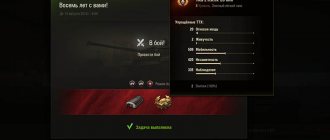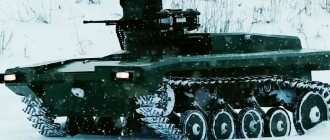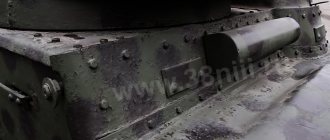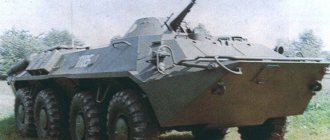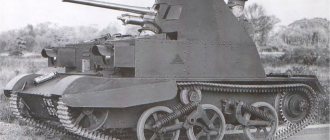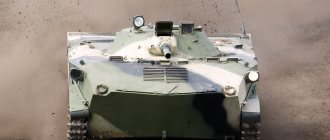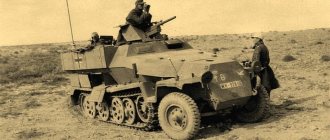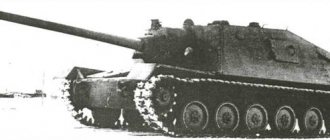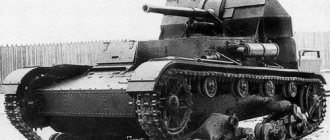History of creation
In the USSR, the first designs of wedges began to appear back in 1919. In the 20s of the 20th century, interest in such machines increased, and by 1930 it was planned to create about 70 wedges, or “escort machine guns,” as they were then called.
Many wedge designs were developed and rejected for various reasons. When Soviet engineers visited Great Britain in 1930, they saw the Carden-Loyd Mk.IV wedge, the most successful and advanced vehicle of its class. It was decided to purchase 20 of these wedges and a license for their production in the USSR. In the same year, the wedge was presented to the command, and an order was given for its large-scale production.
Soviet designers decided to refine the project based on their own experience, and in November 1930 they already had an experimental model. And in January 1931 they completed the prototype T-27. Compared to the Carden-Loyd Mk.IV, the wedge was larger, had increased armor, did not have a turret and differed in engine design.
On February 13, 1931, before testing was completed, the wedge was put into service. Great hopes were placed on it - in the event of war, the T-27 was supposed to become the most popular tank. However, by 1938, wedges as a class were considered insufficiently combat-ready and disappeared from armies around the world. The same fate befell the T-27.
Drum
The main weapon of the VIII Škoda T 27 is a drum with three shells. The time between shots is only 1.8 seconds, so in less than 4 seconds you can deal 720 damage. The entire drum is recharged in 24 seconds. A comfortable indicator with which you will not be switched off from the battle for a long time. Use the drum effectively: aim at vulnerable points (engine, tanks, roller) to not only cause damage to the enemy, but also additionally immobilize or set fire to them. At decisive moments, you can even substitute yourself and take damage in order to deprive your enemy “classmate” of half the strength points. The main thing is not to abuse this from the first minutes of the battle.
TTX
general information
- Combat weight - 2.7 tons;
- Layout diagram - transmission in front, engine in the center, crew behind;
- Crew – 2 people;
- Years of production – 1931-1933
- Years of operation – 1931-1941;
- Quantity produced: 3295 pieces.
Dimensions
- Case length – 2600 mm;
- Case width – 1830 mm;
- Height – 1443 mm;
- Ground clearance – 240 mm.
Booking
- Armor type – homogeneous;
- Body forehead (top) - 10/52°, 10/75°, 10/0° mm/deg;
- Body forehead (bottom) - 10/−15° mm/deg;
- Hull side - 10/0° mm/deg;
- Hull stern (top) - 10/0° mm/deg;
- Hull rear (bottom) - 6/0° mm/deg;
- Bottom – 4 mm;
- Housing roof – 6 mm;
- Tower forehead - 10/30° mm/deg (upper caps);
- Gun mantlet – 10 mm (machine gun shield);
- Tower side - 6/35° mm/deg (upper caps);
- Tower feed - 6/30° mm/deg (upper caps).
Armament
- Machine gun - 7.62 mm DT.
Mobility
- Engine type GAZ-A;
- Engine power – 40 hp;
- Highway speed – 40 km/h;
- Speed over rough terrain – 16 km/h;
- Cruising range on the highway – 120 km;
- Cruising range over rough terrain – 60 km;
- Specific power – 14.8 hp/t;
- Suspension type: locked semi-rigid;
- Specific ground pressure – 0.66 kg/cm²;
- Climbability – 30 degrees;
- The wall to be overcome is 0.5 m;
- The ditch to be overcome is 1.2 m;
- Fordability - 0.5 m.
Modifications and vehicles based on the T-27
The T-27 wedge was very popular at one time and served as the basis for many vehicles:
- T-27M is an experimental self-propelled gun with a 37-mm Hotchkiss gun. Two examples were built. They even passed tests, but were never transferred to the troops;
- T-27 flamethrower. Prototype, 12 produced;
- OT-27 – flamethrower wedge model 1932. The flamethrower was installed in place of one machine gun. She was in the Soviet army until June 1941;
- M3-27 – minelayer with a DT machine gun and 170 mines;
- Supply wedge for transporting cartridges and machine gun discs. It was not adopted for service due to poor maneuverability;
- A tractor based on the T-27 for towing anti-tank guns. Converted from conventional T-27;
- TT-27 – experimental remote-controlled wedge;
- SU-3 with a trouble-free 76-mm Kurchevsky cannon. Didn't pass the test;
- T-27PH - an underwater wedge, could stay under water for half an hour and overcome water obstacles three meters deep;
- AS-T-27 - airfield tractor.
Wedge heel T-27
Wedge heel T-27
In 1930, in order to accelerate the development of armored vehicles and study foreign experience in the USSR, a decision was made to purchase the best models of tanks and armored vehicles abroad. For this purpose, a special purchasing commission was created, headed by the head of the Department of Mechanization and Motorization (UMM) of the Red Army I.A. Khalepsky. The first country where the commission arrived was Great Britain. Of greatest interest here was where, among others, according to the program approved in Moscow, samples of a wedge and a small tank were to be purchased. However, the company categorically refused to sell anything in a single copy, especially with documentation. Therefore, as a result of negotiations conducted by I.A. Khapepsky and a representative of the company ARCOS (All Russian Cooperative Society Limited) with the management, 20 Carden-Loyd Mk VI tankettes and 15 Mk A tanks were purchased (in Soviet documents “VKP” and “ B-26" respectively).
Layout of the T-27 wedge (photocopy from the “Red Army Armor Manual”):
1 - engine: 2 - carburetor: 3 - intake pipe; 4 — exhaust pipe; 5 — oil bypass tube; 6 - distributor and breaker; 7 - dynamo; 8 - fan; 9 - radiator; 10 - water pipe; 11 — clutch housing; 12 — gearbox; 13 — gear shift lever; 14 — cardan; 15 — differential; 16,17 — brake and clutch pedals; 18 — accelerator pedal; 19 — direction control lever; 20 — brake latch rod; 21 — rear pipe; 22 — differential casing; 23 — axle shaft; 24 — front propeller bracket; 25 — rear propulsion bracket; 26 — skating rink; 27—spring; 28 - battery; 29 — drive wheel; 30 — guide wheel; 31 — guide wheel crank; 32 — tension fork; 33 — track tension nut; 34 — frontal removable sheet; 35 — removable differential casing; 36 — air channel; 37 — gas tank; 38 — bracket for the radiator door opening mechanism; 39 — hinged cap; 40 — hatch for inspection of the gearbox and control mechanisms; 41,42 — plugs for draining lubricant from the engine and gearbox; 43 — screw for installing the engine piston at dead center; 44 — seat; 45 — handwheel of the cartridge magazine feeding mechanism; 46.47 - gas and ignition timing levers
The wedges were to be delivered between May and September, 3 to 5 vehicles per month. Each of them cost the treasury 275 pounds sterling, or 7,250 rubles. The first vehicles arrived in the USSR even before the return of the purchasing commission at the end of May 1930. All 20 purchased wedges were distributed as follows: three went to a separate training tank regiment (MVO), five to the 1st Regiment of the Mechanized Brigade (MVO), three to the Oryol Tank School (MVO), one to the School of Military Auto Mechanics (MVO). ), two - to the Armored Tank Courses (LVO), three - to the Military Technical Academy and three - to industrial plants. One (according to other sources - two) of the last three wedges, along with a set of documentation, was sent to the 2nd VATO plant in August 1930. On the instructions of the UMM of the Red Army, the plant was supposed to modernize the English machine and prepare for its mass production. For this purpose, a design group of 5-6 people was created at the plant, headed by N.N. Kozyrev.
The possibility of installing a Ford-AA engine on a wedge instead of a Ford-T was studied by NAMI specialists, who also received one Carden-Loyd Mk VI wedge in July 1930. Since the car plant in Nizhny Novgorod was still under construction and did not produce Ford AA engines, it was planned to import 690 such engines in 1930-1932.
At a meeting of the Revolutionary Military Council of the USSR on August 13, 1930, the 2nd VATO plant was finally determined to be the head plant for the production of VKL wedges. In the same month, OKMO, with the participation of N.N. Kozyrev’s group, considered options for modifying the “VKL” wedge in accordance with the requirements of the UMM of the Red Army and, in particular, its possible transfer to a wheeled-tracked vehicle. At the same time, it was decided to continue work on the T-25 wedge, but in a tracked version and in the image and likeness of the “VKL” wedge, which from that moment began to be called as B-25, or K-25 (“V” - from “ Vickers"; "K" - from "Carden-Loyd"). Thus, despite the partial preservation of the T-25 index, we were talking about a completely different machine.
The first prototype of the K-25 with a Ford AA engine and a plain steel body was produced on November 3, 1930. During testing, in order to save time, the tracks and drive wheels were transferred from the English car. However, the test result was disappointing - the engine overheated, the power reserve was insufficient due to the small capacity of the fuel tank. In addition, the proposed armor of 4 - 7 mm was considered insufficient. In short, the development of the car should have continued.
At the beginning of 1931, the 2nd VATO plant produced a second prototype with a new hull and chassis, reinforced armor and increased dimensions. In this form, the wedge was adopted by the Red Army by decree of the Revolutionary Military Council of the USSR on February 13, 1931 under the designation T-27, despite the fact that state tests of the vehicle had not yet been completed by that time.
The layout of the T-27, as well as most combat vehicles of this class, was characterized by the combination of a control compartment with a combat and engine compartment. In this case, the transmission compartment was located in the front part of the hull.
A tankman in the gunner's place wearing a T-27 wedge. The design of the embrasure for installing a DT machine gun is clearly visible
Rear view of the T-27 wedge. The doors in front of the radiator are open
The driver's seat was located on the left, and the gunner (aka commander) was located to the right of the engine, located in the middle of the hull. To provide thermal insulation and protect crew members from burns, the engine was covered with a hood made of two metal sheets with an air gap between them. Behind the shooter's seat, a battery was placed on two brackets.
In the control department, a steering lever and a pedal shaft were installed in front of the driver, on which three pedals were mounted: clutch, foot brake and accelerator. Between the driver's legs there was a gear shift lever. Below, under his left hand, there was a lever for the cable drive of the radiator dampers, located in the rear part of the hull. A box for tools and spare parts was installed behind the driver. Two more spare parts boxes were attached to the outside of the machines.
The wedge body was assembled from rolled armor plates 4, 6 and 10 mm thick on a frame made of corners using bolts and rivets. On vehicles of the last year of production, the armor plates were connected by welding and only partially by bolts and rivets. All seams at the bottom and along the sides to a height of 400 mm had a canvas lining on red lead, which ensured the waterproofness of the hull when overcoming water obstacles. The upper frontal plate had a hatch for access to the brake rollers, which was closed by an armored cover with nuts on special studs. In addition, a casing was attached to the upper and lower frontal sheets with bolts (on early production vehicles), covering the protruding part of the differential housing. On most wedges, this casing was fastened with rivets and was removed only together with both sheets. In the sloping roof of the transmission compartment there was a hatch with an armored cover on hinges, which provided access to the gearbox and control drives. On vehicles of the first year of production, there was a special hole on the right side for attaching a machine gun mount.
T-27 wedges accompany the T-35 heavy tank at a parade in Kharkov on November 7, 1933
Sitting on a T-27 wedge, the tanker talks with the local population. 1932 (center). The vehicle bears the tactical designations adopted in the Red Army in 1932-1938
T-27 wedges during maneuvers. Ukrainian Military District, 1933
In the front shield on the driver's side there was a viewing slot, which was used when driving the vehicle in a combat situation when the hatch cover was closed. On the gunner's (commander's) side there was a hole that was covered by three 10-mm armored shields of a machine gun mount. The movable shield was attached to the machine gun saddle and moved with it. Two fixed flaps covered it from the sides and were fixed with the help of corners to the roof of the transmission compartment and to the front flap. Narrow horizontal slits were provided in the fixed shields for observing the battlefield. In addition, an armored visor 6 mm thick was installed on top of the hatch cap with bolts. On the side sheets of the hull, cartridge boxes with doors on the stern side were attached to the outside. The box doors were hinged and closed with two bolts.
T-27
Red Army soldiers are studying the design of the T-27 wedge. 1934
In the upper part of the side plates of the hull there were inspection slots with armored flaps, and in the lower part there was a round hole for the passage of the rear tubular axle.
The driver's, gunner's, and engine access hatches were closed with hinged caps. The hinges of the caps were riveted to the sheet above the radiator and had special stops on which the caps rested when opened. The latter were equipped with spring-loaded hooks on the inside, which ensured their closure in the full or slightly open position. For ease of opening, handles were riveted on the inside of the caps. On late-production vehicles, special hatches were made in the hatch covers of the crew members, which were closed with armored flaps. The driver's hatch cover had a hatch in the aft part, the arrow had a hatch in the roof and aft part. A rectangular hatch was made in the hatch cover above the engine for access to the fuel tank filler neck. In front of the power plant cap, a hole was provided for air access to the radiator of the cooling system, which was covered with an armored visor. In the stern plate of the hull in front of the radiator there were special doors that were controlled from the driver’s seat. On wedges of the latest releases, instead of doors, a special armored casing with a hole pointing down was installed.
The bottom of the hull was welded from several sheets and had a trough-shaped depression in the middle. To drain oil from the engine crankcase and gearbox, two holes were made in the bottom, closed with threaded caps.
For towing, a special loop was riveted to the roof of the transmission compartment, and a towing frame with a loop was riveted to the aft part of the hull.
Red Army soldiers get acquainted with the design of the T-27 wedge. Leningrad Military District, November 1939
T-27 wedge heel with early type machine gun installation
The wedge's armament consisted of a 7.62-mm DT machine gun, the ammunition load of which included 2,520 rounds. For shooting, the standard mechanical sight of the machine gun was used. On vehicles of the first year of production, the machine gun was mounted on a special carriage, which ensured vertical guidance of the machine gun. The horizontal rotation of the machine gun was carried out by rotating the machine gun mounting fork in the carriage. On wedges of subsequent releases, the machine gun was installed in a special flange, which provided more convenient guidance both vertically and horizontally, as well as better protection for the shooter from bullets and shrapnel.
A special feature of the T-27 wedge was the layout and supply of ammunition. 40 machine gun discs were located in the side boxes of the hull. The disks could be laid out in two ways. In the first case, the discs were stacked in two rows of 10 pieces in the feed mechanism of each box. The disks were fed using a handwheel and a cable drive reel. When stacking according to the second option, 14 discs were placed in special movable racks in two rows. At the same time, the total number of disks transported on the vehicle was 28 pieces (1764 rounds).
Along the longitudinal axis of the body in its middle part, a 4-cylinder, four-stroke, liquid-cooled in-line Ford-AA (GAZ-AA) engine with a power of 40 hp was installed with the flywheel forward. at 2200 rpm. Engine displacement is 3060 cm3. Carburetor - Ford Zenit. Starting the engine is done using a 0.9 hp starter. and manually, with a crank. The fuel tank capacity was 42 liters. Gasoline was supplied by gravity. The cooling system included a thermosiphon centrifugal pump, a four-blade fan driven by a belt from the crankshaft, and a radiator with a steam-air valve. The capacity of the cooling system was 22 liters. The exhaust system muffler was located outside under the left box of cartridge magazines. It was connected to the engine exhaust pipe by an elbow pipe wrapped in asbestos. Two types of mufflers were installed on the wedges: bolted and welded. Both were interchangeable.
Self-propelled artillery unit T-27M
T-27M wedge with a tracked trailer for transporting ammunition
The transmission, borrowed from the Ford-AA (GAZ-AA) truck, consisted of a single-disc dry friction clutch (steel on ferrodo friction linings), a four-speed gearbox, cardan and main gears, a simple bevel differential with band brakes (rotation mechanism ) and two final drives.
The undercarriage consisted of six single rubber-coated road wheels on board, interlocked in pairs into three balancing bogies mounted on a longitudinal beam, a support beam (wooden with steel frame), a front drive wheel with a non-removable ring gear and a guide wheel with a track tension mechanism. Suspension - spring. The caterpillar was a small-link caterpillar with a 150 mm wide pinion engagement and included 129 tracks. The track pitch is 44 mm. Tracks are cast, made of steel or ductile iron.
The electrical equipment of the machine was carried out using a single-wire circuit with a voltage of 6 V.
There were no means of external or internal communication on the car. Communication between individual machines in the unit was maintained using signal flags.
Serial production of the T-27 wedge began in 1931. The first 45 cars were produced, and subsequently production continued at the 2nd VATO Automobile Plant (since 1932 - Plant No. 37 named after G.K. Ordzhonikidze) and GAZ. The assembly of the hulls was carried out by the KES (Kreking-Electrolocomotive) plant in Podolsk, which received armor plate from the Izhora plant.
During mass production, attempts were made to improve the design of the T-27 wedge. In 1932, the UMM Design Bureau under the leadership of N.I. Dyrenkov, together with the 2nd VATO plant, designed the D-44 wedge. It was a T-27 with a rotating turret and an improved suspension, the design of which, however, did not differ from the design used on the T-27.
In the fall of 1932, a representative of the Office of the Chief of Armaments of the Red Army, engineer P.L. Kozhevnikov, developed a hydromechanical transmission for the T-27 wedge, which remained on paper.
At the same time, on the initiative of the Design Bureau under the leadership of K. Lebedev, experimental work was carried out on installing mud flaps over the tracks on the T-27, attaching an entrenching tool and installing a special filter to prevent tank crews from being poisoned by gasoline vapors and exhaust gases.
Self-propelled gun T-27
Self-propelled gun SU-76K
| Production of T-27 wedges | |||||
| Manufacturing plant | 1931 | 1932 | 1933 | 1934 | Total |
| "Bolshevik" | 45 | — | — | — | 45 |
| № 37 | 303 | 1610 | 919 | 14 | 2846 |
| GAS | — | 83 | 323 | — | 406 |
| Total | 348 | 1693 | 1242 | 14 | 3297 |
It should also be noted that the T-27 wedge was used as an experimental vehicle when testing a special protective fence against attacks by demolition dogs. It consisted of four metal meshes made of 1-mm wire, which were energized and prevented dogs with explosives from jumping or crawling under the wedge. The nets were attached to the wedge and were powered by its electrical network.
Almost immediately after the start of mass production of the T-27 wedge, designers began work on creating a variety of combat and auxiliary vehicles based on it.
So, already in November 1931, together with the OAT design bureau, a project was developed to install a 20-mm automatic cannon of the 1930 model in the T-27 wedge instead of a DT machine gun. The horizontal pointing angle of the gun was 10°, the elevation angle was +15°. Rate of fire - 130 - 135 rounds/min, table firing range - 2000 m. Food - magazine, from clips of 20 shots each. The ammunition included fragmentation and armor-piercing shells with an initial speed of 845 and 815 m/s, respectively. The project of this anti-tank wedge was not realized in metal due to the removal of this gun from production and armament.
Speaking about self-propelled artillery units created on the basis of the T-27, first of all it is necessary to focus on two vehicles designed by the head of the tank department K.K. Sirken.
Self-propelled gun SU-76K
The first of them, designated T-27M (or T-27S), differed from the serial tankette in its slightly modified armored hull and chassis. A 37-mm Hotchkiss cannon was installed in the armored hull of the vehicle on the right with horizontal guidance angles in the 18° sector and vertical guidance in the range from -5° 15″ to +9°10″. A DT machine gun was located above the cannon in a self-contained installation. Due to the small reserved volume of the vehicle, most of the ammunition was transported in a special tracked trailer.
The chassis of the vehicle for one side consisted of three bogies with two rubber-coated road wheels in each. The front bogie is a balancer, with an axle in the crawler frame. The two rear bogies were combined by a spring into a carriage, which was attached to a transverse pipe. Two small diameter rubber support rollers were suspended on a leaf spring.
The vehicle had duplicate controls from the commander's seat. Armor protection and mobility characteristics remained the same as the base vehicle.
A prototype of the T-27M self-propelled gun was manufactured in April - May 1932. During the tests carried out at the NIBT Test Site, numerous shortcomings were identified, in particular: the inability to use the gun sight for firing a machine gun, imperfect ammunition storage, poor design of the armor for the radiator of the engine cooling system, which led to its overheating, and difficult movement control from the commander’s seat.
The second model of the self-propelled gun differed from the first in the presence of only cannon armament and the design of the chassis. Due to the absence of a machine gun above the cannon, the height of the line of fire and, accordingly, the declination angle increased. The chassis had a semi-rigid suspension with leaf springs as an elastic element. On the side of each side, four rubberized road wheels were installed, interlocked in pairs into two carriages, the axes of which were fixed in the propulsion frame. Compared to the T-27 road wheels, the self-propelled rollers had an increased diameter. The guide wheel was raised. In addition, there were two rubberized unsprung support rollers on each side.
A prototype of this self-propelled unit was made, but it had many of the shortcomings of the previous vehicle. Further work on these installations was stopped.
Self-propelled gun SU-76 in combat (right) and traveling (center) position
Flamethrower wedge XT-27 (BKhM-4)
In December 1931, the UMM of the Red Army approved the terms of reference for the small artillery self-propelled gun SU-3 - the installation of a 76-mm dynamo-reactive (recoilless) gun "K" designed by L.V. Kurchevsky on a T-27 wedge. This self-propelled gun was intended to operate as part of reconnaissance detachments and escort cavalry. The SU-3 was developed in 1933 at Plant No. 7 and a prototype was produced in the same year. The Kurchevsky gun was installed instead of the standard DT machine gun on the starboard side of the vehicle and had a horizontal pointing angle of 5°, and a vertical pointing angle from -1° to +5°. The initial velocity of the projectile was 300 m/s. Ammunition - 30 shots. The gun was equipped with an automatic reloading mechanism. All its parts, except the nozzle and tray, were protected by 6- and 9-mm armor. The engine, transmission and chassis of the unit remained unchanged (compared to the T-27). From April 15 to April 25, 1933, the SU-3 was tested at the VAMM training ground named after Stalin in Kuntsevo. During the tests, the barrel ruptured, and as a result of the explosion, the tester A.Ya. Neyland, who was firing, died. After repairs at Plant No. 8 in Podlipki, the SU-3 was demonstrated to the authorities at the chemical test site in Kuzminki.
On August 5, 1933, the Revolutionary Military Council of the USSR approved the “Red Army Artillery System for the Second Five-Year Plan.” As part of this program, in 1934, a battalion 45-mm universal cannon self-propelled gun was developed on the T-27 chassis. In the same year, a self-propelled unit SU-76 was designed in a special design bureau under the leadership of I.A. Makhanov. By analogy with the 45-mm installation, the 76-mm regimental gun of the 1927 model, covered with a shield, was installed in the rear of the T-27 chassis. When firing, to give the vehicle stability, two openers were folded back. In order to reduce the height of the line of fire to 1250 mm, the layout of the engine compartment of the vehicle was changed - the gas tank and radiator of the cooling system were moved. The horizontal guidance angle was possible in the 36° sector without turning the vehicle, since the gun was borrowed along with the upper machine. Vertical guidance angle - from -3° to +35°. Due to the small size of the vehicle, it was not possible to accommodate either a full gun crew or ammunition. Therefore, the SU-76 was accompanied by another vehicle, developed on the basis of the T-27 wedge for transporting crews and ammunition. However, this was also the main drawback of the self-propelled gun. The division of a combat unit “gun + crew + ammunition” into two vehicles could lead to separation of the crew with ammunition from the gun in battle (for example, due to engine or chassis failure). Three prototypes of the SU-76 were produced in 1935.
Flamethrower wedge XT-27. The casings covering the cylinders with fire mixture and its supply pipelines are clearly visible
Supply wedge based on T-27
Unlike the self-propelled guns, the flamethrower version of the T-27 tankette was mass-produced and was in service with the Red Army. Its prototype OT-27 (ХТ-27 or БХМ-4) was manufactured (actually converted from a linear one) at Moscow in December 1931. In the summer of the following year, the wedge was tested at the Chemical Testing Site of the Chemical Advanced Courses for Command Staff of the Red Army and was put into service. In 1932 - 1933, 187 wedges were converted into flamethrowers.
In 1932, at the Central Laboratory of Wired Communications, by order of the Communications Directorate and the UMM of the Red Army, they developed the TT-27 remote-controlled wedge. At the end of the year, a pilot batch of five vehicles was produced. In January - February 1933, they participated in tactical exercises of the Leningrad Military District. The teletankette differed from the serial T-27 vehicle only in the placement of television equipment on it, which was extremely unsuccessful. Therefore, further work on the TT-27 was considered inappropriate.
In 1932 - 1933, HATH, under the leadership of engineer N.I. Korotonozhko, based on the T-27 wedge, designed a supply wedge. It was intended for transporting ammunition to positions in the enemy fire zone and could accommodate 40 ammunition boxes (80 zinc boxes) weighing 880 kg and 24 equipped machine-gun disks. The supply vehicle differed from the basic one in the presence of a self-unloading mechanism and a modified design of the onboard cartridge boxes. The design of the self-unloading mechanism was based on the principle of roller tables. The unloading mechanism was activated from the driver's seat. A prototype supply wedge was produced in 1933.
In 1934, a wooden mechanized bridge was built and tested for the T-27 wedge. Its length reached 4.5 m, and the time required to install the bridge on the wedge was about 2 hours. After military tests, further work on installing wooden bridges on the T-27 wedge was stopped.
In the same year, NIBTPolygon specialists, based on the serial T-27 wedge, produced a prototype of the T-27PH underwater wedge. With the help of installed equipment and measures taken to seal the vehicle, the T-27PH wedge could overcome water obstacles up to 4 m deep.
In 1934, a prototype of the MZ-27 minelayer was created. Its main purpose was to construct minefields in the area of rifle and machine-gun fire immediately before an enemy tank attack. The minelayer differed from the serial T-27 wedge in the installation of special equipment for laying anti-tank mines. The release of mines was carried out using a special mechanism, which consisted of a drum with a cable and an anchor. When the car moved, the anchor was dropped to the ground and clung to the ground. With further movement of the wedge, the cable unwound and rotated the clip with mines in the drum. Mines placed in a clip fell out through the outlet hole in the drum under the influence of their own gravity. Mining could be carried out at any speed. The mines were scattered in one row at intervals of 0.9 - 1.1 m. The drum was made of 10 mm armor and installed in the rear of the vehicle between the cartridge boxes. It contained 170 anti-tank mines. Mining time was 16 - 20 s; equipping the drum took 4 - 5 minutes. The MZ-27 combat vehicle was not mass-produced.
As for the T-27 linear wedges, the start of their mass production coincided with the deployment of mechanized troops of the Red Army.
A prototype of the MZ-27 minelayer. The drum with mines mounted in the rear of the vehicle's hull is clearly visible
Laying mines using the MZ-27 minelayer
In May 1930, the first permanent formation of motorized mechanized troops was formed - a mechanized brigade.
The first such brigade was formed in the area of Naro-Fominsk (Moscow region), where at that time experimental work was carried out in the field of armored vehicles, the organization of troops and their training.
In the period 1930 - 1931, experimental exercises of the brigade took place in Ukraine and Belarus, during which issues of operational-tactical use were studied and the most appropriate organizational structure of a mechanized formation was developed.
The results of these exercises revealed a number of significant shortcomings in the organization of the brigade and its armament: it turned out to be inactive and not powerful enough to carry out independent tasks. The T-18 (MS-1) tanks, in terms of their tactical and technical characteristics, did not meet many of the requirements that were placed on them by the tactics and operational art of that time: they had low mobility and often failed for technical reasons. Therefore, in the spring of 1931, the mechanized brigade was reorganized. The basis for the new organization of the brigade was the requirement of the Revolutionary Military Council of the USSR: “To create a highly mobile and sufficiently powerful mechanized formation capable of acting as an army mobile long-range strike group and incorporating the necessary means to ensure the ability to carry out independent operational tasks in isolation from the main forces of the army "
This requirement was implemented during the transition to a new brigade organization based on the battalion system.
Now it included four main elements: a strike group (three tank battalions); fire reinforcement means (artillery battalion); combat support assets (reconnaissance battalion, rifle and machine gun battalion, tank destroyer battalion, engineer battalion, chemical company, anti-aircraft machine gun battery); logistics support (vehicle delivery company, technical base) and control equipment (communications company, communications aircraft flight).
T-27 wedge supports cavalry attack
T-27 wedge heel on a PD-T suspension under a TB-3 bomber
T-27 wedge heel that was blown up by a mine. Soviet-Finnish War, December 1939
Simultaneously with the change in the organizational structure of the mechanized brigade, it was re-equipped with T-26 and BT tanks, as well as T-27 wedges.
As a result, the mechanized brigade became a fairly powerful unit, consisting of 178 T-26 tanks, 32 BT-2 tanks, 91 T-27 tankettes, 48 armored vehicles, 46 mobile artillery guns, 39 76-mm caliber guns, 7 anti-aircraft guns guns, 7 anti-aircraft machine guns and over 600 vehicles of various types.
Following the 1st mechanized brigade, the deployment of other mechanized units and formations began. In 1932, five separate mechanized brigades were formed: the 2nd - in the Ukrainian, 3rd, 4th and 5th - in the Belarusian military districts, and the 6th - in the Special Red Banner Far Eastern Army. In addition, two tank regiments, four mechanized cavalry divisions, 15 tank and 65 tank battalions and a company for rifle divisions were formed. A significant proportion of the armored vehicles of these formations and units were T-27 tankettes.
In the autumn of 1932, the organizational deployment of mechanized corps began in the Moscow, Ukrainian and Leningrad military districts. In the period from 1933 to 1935, the Red Army units had the maximum number of T-27 tankettes. Beginning in 1934, small amphibious tanks T-37A began to arrive in large numbers, gradually displacing T-27 tankettes.
The T-27 wedges received their baptism of fire in Central Asia in battles with the Basmachi. Despite the fact that their main groups were defeated in 1926, battles between the Basmachi and units of the OGPU (NKVD) and the Red Army continued until the mid-1930s. The situation was especially difficult in Turkmenistan. The 3rd Turkmen Rifle, 1st Turkestan and Turkmen Mountain Rifle and 18th Turkmen Mountain Cavalry divisions were stationed here. These formations included tank companies and an armored squadron, which were also armed with T-27 tankettes. In the mid-1930s, a light tank regiment was formed in the Central Asian Military District, equipped with T-26 light tanks and T-27 tankettes.
The low weight and dimensions of the T-27 wedge turned out to be attractive for use in airborne assault forces. In 1932, they produced a sample of the PD-T system for dropping it with a parachute. Since the weight of the wedge significantly exceeded the maximum permissible load of the TB-1 bomber, it was lightened by 344 kg, removing everything that was possible, and even draining the water from the cooling system. The plane also had to be lightened. In December 1932, the PD-T system was tested at the Air Force Research Institute. It became the prototype of a large number of similar devices designed for landing light tanks, armored vehicles and cars.
T-27 wedge, converted into an artillery tractor
T-27 wedge tractor with a 45 mm cannon in tow. 1939
In 1933, the only export delivery of T-27 wedges took place - to Mongolia. By this time, a separate armored regiment had been formed in the Mongolian People's Revolutionary Army. It received 10 T-27 tankettes and 10 BA-27 armored vehicles supplied from the Soviet Union. True, these vehicles did not participate in the conflict near the Khalkhin Gol River. They were not included in the 57th Special Corps (from June 19, 1939 - 1st Army Group).
The T-27 wedges also found use in the Soviet-Finnish war. By its beginning, most of them were transferred to rifle formations, where they were used as tractors and transporters for the supply of ammunition. However, the technical condition of these vehicles, as a rule, left much to be desired, and cross-country ability in winter conditions in Karelia was practically zero. Nevertheless, in many units the T-27 coped with the tasks assigned to them, and in the 14th Army, for example, they were also involved in road patrols.
As of June 1, 1941, the Red Army had 2,558 T-27 tankettes, of which 188 were in warehouses and repair bases. 584 vehicles required medium repairs, 840 required major repairs. Serviceable tankettes were used as artillery tractors for 45-mm anti-tank guns, and mainly as training vehicles for training driver mechanics, including for so-called “new types” of tanks. For example, a directive of the General Staff of the Red Army dated December 3, 1940 ordered that “for training personnel and saving the material of combat vehicles, 10 T-27 tankettes should be released for each battalion of heavy tanks, exclusively as training ones.” It is difficult to understand how, having mastered driving a T-27 wedge, one could learn to drive a heavy KV.
All tankettes located in the border military districts (1087 units) were lost in the very first days of the Great Patriotic War. And mostly without leaving the location of the military units. They were simply abandoned in the parks as having no combat value. Only a few episodes are known about the combat use of T-27 wedges during the war. In 1941 - 1942 they were used by troops of the Karelian Front, in particular, in the already mentioned 14th Army. On May 1, 1942, the tank company of the security battalion of the headquarters of this army had 23 T-27 tankettes. In October 1941, a separate tank detachment of the 1st People's Militia Regiment, which participated in the defense of Kharkov, also had several T-27 tankettes. During the Battle of Moscow on December 1, 1941, several T-27 tankettes supported the attack of one of the battalions of the 71st Separate Marine Rifle Brigade in the Yakhroma area.
During the war, several hundred T-27s were used as training vehicles in OSOAVIAKHIM organizations to train drivers and tractor drivers.
A fairly significant number of tankettes remained in Red Army units in the Far East. Thus, on September 1, 1940, the troops of the Far Eastern Front had 264 linear and 36 chemical T-27s. On August 5, 1945, the 1st Far Eastern Front included 52 tankettes, the 2nd Far Eastern Front - 56, and the Trans-Baikal Front - 97. Most of them were in warehouses. There is no data on the participation of T-27 tankettes in combat operations against Japanese troops in 1945.
Repair of T-27 wedges at one of the Moscow enterprises. 1941
The T-27 wedge is a monument to the 2nd Rifle Corps. Alakurtti village, Murmansk region
| Tactical and technical characteristics of wedges | ||||||
| Car make | "Carden-Loyd" Mk VI | TKS | CV3/35 | vz.33 | UE | T-27 |
| Combat weight, t | 1,4 | 2,65 | 3,5 | 2,3 | 2,1 | 2,7 |
| Overall dimensions, mm: | ||||||
| length | 2460 | 2560 | 3150 | 2700 | 2800 | 2600 |
| width | 1700 | 1760 | 1500 | 1750 | 1740 | 1825 |
| height | 1220 | 1330 | 1300 | 1450 | 1250 | 1443 |
| clearance | 290 | 330 | 190 | 260 | 240 | |
| Max, speed, km/h | 45 | 40 | 42 | 35 | 30 | 42 |
| Cruising range, km | 160 | 180 | 150 | 100 | 60 | 110 |
Use in combat
Initially, it was planned to use the T-27 to escort heavy tanks, as well as for communications and reconnaissance. The vehicle was not suitable for these purposes, and it was transferred to cavalry and rifle divisions. Quite quickly, the T-27 began to be considered not as combat, but as training vehicles. Very often, wedges were used at maneuvers and parades, as well as for experiments, for example, in air transportation.
The T-27 took part in battles in Central Asia against the Basmachi, and about a hundred vehicles took part in the Soviet-Finnish war.
In general, the wedge showed itself to be an unpretentious and simple machine, but it was significantly inferior to the newly developed tanks, and its production turned out to be labor-intensive and expensive, which ultimately led to the disappearance of wedges as a class.
In May 1941, the T-27 was completely withdrawn from service, although several vehicles still remained in the army - they were often trained as driver mechanics or used for auxiliary purposes. Some of the tankettes took part in the battles of the Great Patriotic War. The last time they are mentioned is in reports of battles near Moscow and in Crimea.
Tank photos
ConstructionEdit
The T-27 was a classic wedge without a turret. The layout of the wedge was distinguished by its high density. In the front part of the hull there was a transmission, in the middle part there was an engine and in the rear part there was a crew consisting of 2 people (a driver and a machine gunner commander). In the upper part of the hull there were 3 hinged caps, blocking access to the seats of the driver, commander-machine gunner and the power plant.
BookingEdit
The armor protection of the wedge was made from sheets of rolled homogeneous armor, connected with bolts and rivets on an angle frame (welding was used on some of the vehicles). The armor plates of the hull were placed mostly vertically, without tilting (with the exception of part of the frontal armor and upper caps). The thickness of the armor is mainly 10 mm (caps, except for the front part, 6 mm). The armor provided protection only from small arms bullets and fragments of mines and shells, and even then not in all cases.
WeaponsEdit
The wedge was armed with one 7.62-mm DT machine gun, located in the front hull panel on the right. The machine gun's ammunition capacity was 2,520 rounds (40 magazines), later the ammunition was reduced to 28 magazines (1,764 rounds).
Surveillance and communication devicesEdit
The T-27 did not have any surveillance or communication devices. Observation in a combat situation was carried out by the driver through the viewing slot, and by the machine gunner through the machine gun sight. Communication with other machines was supposed to be maintained using signal flags.
MobilityEdit
The wedge was equipped with a four-stroke four-cylinder liquid-cooled carburetor engine Ford-AA (GAZ-AA) with a power of 40 hp. s., mounted with the flywheel forward. The transmission (borrowed from a Ford-AA/GAZ-AA truck) was mechanical, consisted of a dry single-plate clutch, a four-speed gearbox (4 forward gears and one reverse), the turning mechanism ensured that the vehicle turned on the spot (minimum turning radius in 1st and 2nd th gears), a simple differential with shoe brakes. The wedge had a semi-rigid locked suspension, consisting of six dual road wheels on board, interlocked in pairs into bogies. The elastic element of the suspension was leaf springs. The wedge's tracked propulsion system consisted of a small-link lantern gear chain with an open hinge, two rear-mounted guide wheels with a crank track tensioning mechanism, 12 road wheels with external shock absorption, two front-mounted lantern gear drive wheels and two small-link caterpillar chains with a width of 150 mm.
Layout
The T-27 wedge was configured classically for this type of vehicle without a turret with a high density of specific placement of components and assemblies per unit area. The transmission compartment was located in the front part of the hull, the engine was located in the middle part, and the wedge crew was located in the aft part, which consisted of 2 people: the commander, who was also a machine gunner, and the driver. The commander was located on the right side of the hull, and the driver was on the left.
Wedge heel T-27 and light tank T-18 Orel 1932
